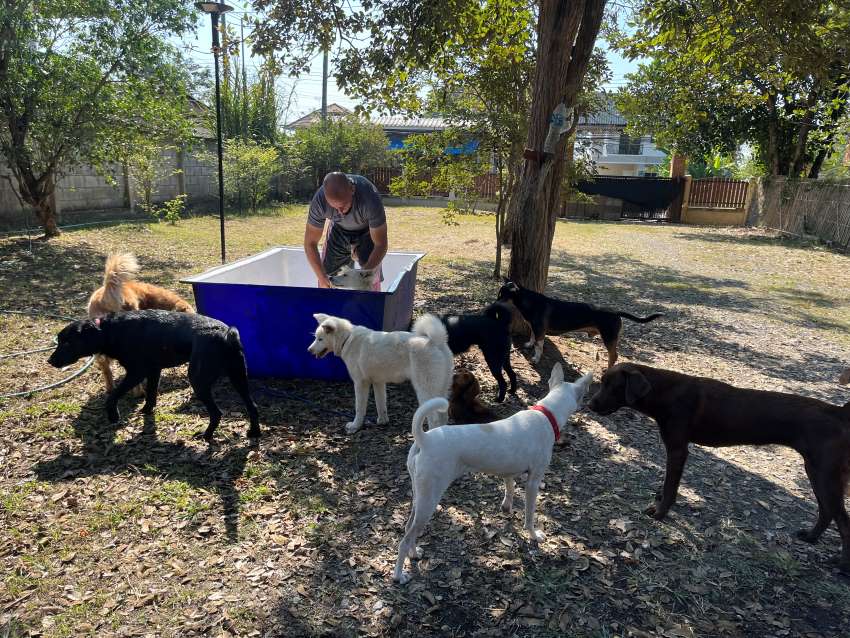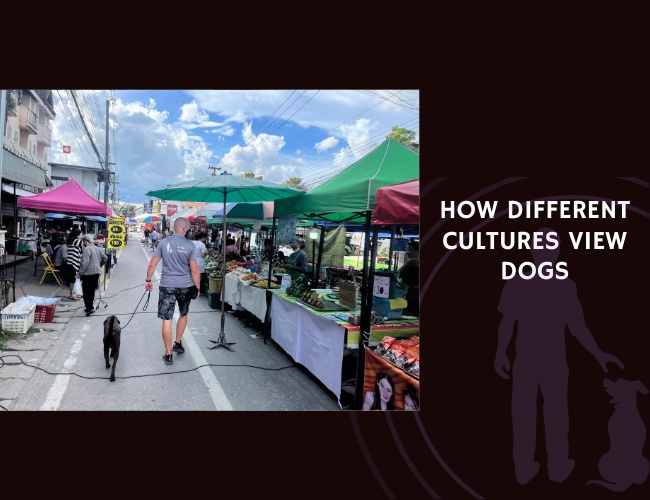Introduction to Cultural Perspectives on Dogs
Dogs, often referred to as “man’s best friend,” occupy a unique place in human societies across the globe. Their roles and the way people perceive them can significantly vary from one culture to another. To truly appreciate these differences, it’s crucial to take a global journey through canine relationships and understand the intricacies of these diverse viewpoints.
Cross-Cultural Interactions with Dogs
Many societies have developed a strong bond with dogs, yet each culture has its distinct way of interacting with and treating them. In Western societies, particularly in countries like the United States and the United Kingdom, dogs are primarily considered family members. They live within homes, sleep on plush beds, and are often treated with the same level of care and affection reserved for human relatives.
On the other side of the world, Japanese culture can exhibit a different approach. While urban Japanese dog owners may treat their pets with high regard, often dressing them in clothes and carrying them in designer bags, these actions reflect a different mental framework. Here, dogs can sometimes be viewed more as accessories or symbols of status rather than mere family members.
Understanding Cultural Differences in Dog-Human Relationships
It’s essential to acknowledge and respect these cultural differences for several reasons:
- Enhanced Communication: Understanding these differences can improve the interactions between people from diverse backgrounds, fostering a more inclusive and harmonious global community.
- Better Pet Welfare: By learning how different cultures view and care for dogs, advocacy for better and more universal animal welfare standards can be more effectively tailored and implemented.
- Historical and Social Context: Recognizing the interplay between historical context and societal development helps clarify why certain roles and attitudes towards dogs have evolved in specific ways.
The Varying Roles of Dogs Across Societies
Throughout history, the roles that dogs play in human societies have been influenced by geographical, economic, religious, and social factors. Here are a few key roles dogs have held:
- Companions: In many modern societies, dogs are primarily seen as treasured companions. This role is particularly prevalent in urban settings where dog ownership often centers around emotional support and companionship.
- Workers: In rural and pastoral societies, dogs have traditionally taken on working roles. From herding livestock to protecting property, these working dogs are indispensable for the daily functioning of their human counterparts.
- Status Symbols: In some cultures, dogs can be a status symbol reflecting the owner’s wealth and social standing. This can be seen in practices such as grooming, dressing, and the brands of dog accessories being promoted.
- Cultural Icons: Dogs also serve as cultural symbols in many societies. For instance, they are revered in some folklores and mythologies, symbolizing protection, loyalty, or even luck.
Understanding these varying roles helps us to appreciate the multifaceted ways in which human-dog relationships are woven into the very fabric of cultural identities.
By exploring how different cultures perceive and interact with dogs, we open our minds to the vast tapestry of human-dog relationships around the world, setting the stage for a deeper discussion of the historical and social factors that shape these views.
Historical Evolution of Human-Dog Relationships
Ancient Cultural Perspectives on Dogs and Their Roles
Dogs have held various roles and meanings across different cultures throughout history. In ancient Egypt, dogs were associated with the god Anubis and played a part in the afterlife beliefs. They were often seen as protectors and guides in the spiritual realm. Similarly, in ancient Mesopotamia, dogs were used in hunting and guarding roles, but they also held a revered status due to their close association with the goddess Gula, a deity of healing.
Meanwhile, in ancient China, dogs were valued for their guarding and hunting skills. They were essential in agricultural societies, helping to protect livestock and property. The Chinese also associated certain breeds with the qualities of loyalty and bravery, often depicted in art and folklore.
Transformation of Dog Roles From Working Animals to Companions
Over time, the role of dogs in human society has evolved significantly. Originally kept mostly for their utility, such as hunting, herding, and guarding, dogs gradually transitioned into becoming companions. This shift is particularly evident in Western societies. During the Victorian era in the UK, the concept of keeping dogs purely for companionship gained popularity. This period saw a rise in breed clubs and dog shows, where the aesthetic and temperament of dogs were emphasized over their working capabilities.
As societies industrialized and urbanized, the need for working dogs diminished, and the emotional bonds between humans and dogs strengthened. Dogs began to be seen not just as tools for work but as loyal companions offering emotional support and affection. The invention of pet-related industries like pet food, veterinary care, and grooming services further solidified the role of dogs as family members rather than mere workers.
Key Historical Factors That Shaped Current Cultural Attitudes
Several key historical factors influenced current cultural attitudes towards dogs:
- Urbanization: As populations moved from rural to urban areas, the practical roles of dogs in farming and hunting decreased. This shift allowed for a more intimate relationship between humans and dogs, focusing on companionship.
- Industrial Revolution: The rise of the middle class and the increase in disposable income allowed more people to keep pets and invest in their well-being. Dog breeding for specific traits became more common, furthering the emotional bonds between owners and pets.
- War and Conflict: During times of war, dogs served crucial roles as messengers, scouts, and companions for soldiers. Their bravery and loyalty in these contexts left a lasting impact on how societies viewed dogs, often elevating their status upon returning from the battlefield.
- Media and Pop Culture: The depiction of dogs in movies, literature, and television has played a significant role in shaping public perception. Iconic dog characters in films and books have endeared these animals to audiences, reinforcing the notion of dogs as beloved companions.
Understanding the historical context of human-dog relationships highlights the dynamic and evolving bond between these species. While practical roles may have initially defined these relationships, the emotional connection has transformed and deepened over the millennia, reflecting broader societal changes.
Recognizing these shifts aids us in appreciating the diverse perspectives and roles that dogs continue to play in different cultures today.

How Different Cultures View Dogs
Dogs hold a variety of roles and meanings across different cultures, reflecting the diverse ways in which societies interact with these animals. In Western cultures, particularly in countries like the United States and the United Kingdom, dogs are often seen as beloved family members. They share homes with their human companions and are treated with care and affection akin to that given to human relatives. This perspective emphasizes companionship and emotional support, highlighting the deep bond between humans and dogs.
Conversely, in some Eastern cultures, such as Japan, dogs can be perceived differently. While urban Japanese dog owners may treat their pets with high regard, often dressing them in clothes and carrying them in designer bags, these actions reflect a different mental framework. Here, dogs can sometimes be viewed more as accessories or symbols of status rather than mere family members. This cultural nuance underscores how societal values and aesthetics influence the perception and treatment of dogs.
In other parts of the world, such as among the Aborigines of Arnhem Land in Australia, dogs are revered as the mortal representation of the Creator. This spiritual significance highlights the sacred role dogs can play in certain indigenous cultures, where they are seen as integral to religious and mythological narratives. These varying perspectives illustrate the rich tapestry of human-dog relationships globally, shaped by historical, social, and religious influences.
Eastern vs Western Cultural Perspectives
Comparison of dog perception in Japanese and UK cultures
When comparing how dogs are perceived in Japan versus the United Kingdom (UK), it’s evident that cultural backgrounds greatly influence these perspectives. In the UK, dogs are primarily viewed as family members. They often share homes with their human companions, enjoy regular meals, exercise, and medical care equivalent to a human family member. This close-knit relationship is a hallmark of Western attitudes towards dogs, reflecting the broader cultural emphasis on companionship and affection. 🐶
Conversely, in Japan, while there is a growing trend to treat dogs as significant members of the household, many still perceive them as symbols of status and style. Japanese society tends to value aesthetics and presentation highly, which translates into how pet dogs are treated. Many small dog breeds are favored for their appearance and convenience in urban environments. These dogs are often dressed in intricate outfits and accessories, reflecting a cultural penchant for uniformity and fashion. This doesn’t mean that dogs are not loved; instead, it highlights how cultural values can shape the nature of the loving relationship between humans and pets.
Differences in viewing dogs as family members versus accessories
The fundamental difference in seeing dogs as part of the family versus accessories is prominently highlighted in this Eastern and Western paradigm.
- Family Members (UK):
- Dogs enjoy an inclusive family lifestyle.
- Significant focus on emotional bonding and shared activities.
- Dogs often live indoors and have special spaces and beds.
- There’s a strong emphasis on veterinary care and nutrition.
- Accessories (Japan):
- Dogs are sometimes viewed more as part of one’s outward persona.
- Dogs’ appearances are often highly curated.
- Fashion and aesthetics influence pet care routines.
- Smaller breeds are more common due to urban living constraints.
Impact of cultural values on dog care practices
Cultural values immensely shape how dogs are cared for in these diverse environments. In the UK, the healthcare of dogs is paramount, with regular veterinary checkups, vaccinations, and grooming, all forming a critical part of responsible pet ownership. There’s a nationwide appreciation for canine welfare organizations, and laws are stringent about animal rights and care standards. The cultural notion of dogs as sentient beings deserving care and respect ensures high treatment standards.
Japan’s approach, while less intense about medical care compared to the UK, prioritizes grooming, cleanliness, and public behavior. In urban areas, you’ll frequently see dog strollers and specially designed bags for dogs, which reflect the societal priorities on neatness and convenience. Japanese pet owners often engage professional services for pet grooming and training, emphasizing obedience and behavior, illustrating a society where public harmony and cleanliness are paramount.
Both cultures, though different in their approaches, reflect a profound love and care for dogs, shaped by distinct societal values and living conditions.
Understanding these cultural differences is crucial for fostering better global communication when it comes to dog care practices. It underlines how historical, social, and economic contexts influence our perceptions and behaviors, ensuring a more harmonious coexistence between humans and their canine companions.
By appreciating these diverse cultural narratives, we can enrich our understanding of global canine-human relationships.

Religious and Cultural Influences
Impact of religious beliefs on attitudes toward dogs
Religious beliefs have long played a significant role in shaping how different cultures perceive and interact with dogs. These beliefs often influence the roles dogs play in society, how they are treated, and their overall status.
Islam and dogs
Within Islamic teachings, dogs are often viewed with a degree of caution. The Hadiths (sayings of the Prophet Muhammad) mention that dogs are to be regarded as impure. As a result, many practicing Muslims avoid keeping dogs as pets, especially indoors. However, this does not mean that dogs are wholly unwelcome in Islamic societies. Dogs are considered useful, particularly as working animals such as guard dogs and hunting companions.
Despite the perception of impurity, there are also teachings emphasizing kindness towards all creatures, including dogs. Some Muslims engage in acts of charity by feeding and providing for stray dogs, highlighting a compassionate side to religious doctrine.
Christianity and dogs
Christianity generally holds more favorable views towards dogs. Historically, dogs have been perceived as loyal companions and helpers. This positive attitude can be traced back to biblical references where dogs are mentioned in neutral or positive contexts.
For many Christians, having a dog as part of the family aligns with their values of companionship and care. This has influenced the treatment of dogs, often elevating them to the status of beloved family members. As a result, countries with significant Christian populations, like the US and many parts of Europe, commonly see pets given extensive care and affection.
Hinduism and dogs
Dogs have a complex place within Hindu culture. On one hand, they are celebrated in certain festivals like Kukur Tihar in Nepal, where dogs are adorned with garlands and given special treats. This tradition honors the bond between humans and dogs, recognizing them as loyal protectors and faithful companions.
However, in broader Hindu society, dogs can be seen as both sacred and impure. While some deities have dogs as their vahanas (vehicles), street dogs often receive less affectionate treatment due to their association with negative elements in certain religious texts. Despite this, there is a growing movement within urban areas towards better treatment and welfare for dogs, influenced by changing societal norms and legal frameworks.
Varying status of dogs in different religious contexts
The status of dogs varies significantly across different religious contexts. In some cultures, religious beliefs elevate dogs to a revered status, while in others, they may face restrictions or lower regard. These statuses often reflect long-standing traditions and scriptural interpretations.
- Judaism: Dogs are considered neutral, neither specifically revered nor reviled. They are largely seen through a practical lens, valued for their roles as protectors and companions.
- Buddhism: Reflecting the principle of compassion for all sentient beings, many Buddhists treat animals, including dogs, with respect and care. However, this care is often balanced with practicality, such as the role of dogs in rural communities as workers.
- Zoroastrianism: Dogs hold an almost sacred status. They are considered pure and are deeply revered, often treated with high regard and seen as spiritual protectors.
How cultural beliefs shape treatment and welfare standards
Cultural beliefs heavily influence the treatment and welfare standards of dogs. Societies embed their religious teachings into laws, societal norms, and daily practices, affecting how dogs are perceived and cared for.
- Care practices: In cultures where dogs are highly valued, veterinary care, grooming, and nutrition are prioritized. This is evident in Western societies where dogs are considered family members and receive extensive healthcare.
- Stray management: In societies where dogs may be seen as impure or less valued, strays often face harsher conditions. However, even in these contexts, there are efforts, often led by non-governmental organizations (NGOs) or compassionate individuals, to improve the welfare of stray dogs.
- Legal protections: Religious and cultural attitudes often influence the legal framework around animal welfare. Countries with favorable attitudes towards dogs typically have stringent laws protecting their rights and welfare.
Understanding these cultural and religious influences is crucial for international efforts aimed at improving animal welfare standards. It fosters empathy and effective communication across different societies, enhancing global initiatives to support and protect dogs.
By recognizing and respecting these diverse perspectives, we can work towards creating a more compassionate world for all dogs, regardless of cultural background.
Working Dogs Across Cultures
Dogs have been more than just pets for centuries. Their unique abilities make them indispensable in various roles across different societies. These working dogs, whether herding sheep in rural areas or aiding police in urban settings, showcase their versatility and intelligence.
Different roles of working dogs in various societies
The roles that dogs play in different areas can vary broadly, often reflecting the demands and values of that culture. Here are some notable roles:
- Herding Dogs: In pastoral societies, dogs have long been used to manage livestock. Breeds like Border Collies in the UK or Australian Shepherds in Australia have been bred precisely for their herding instincts and ability to work tirelessly alongside shepherds.
- Guard Dogs: In many parts of the world, dogs are essential for security. In rural African communities, dogs are used to protect homes and livestock from predators and thieves. Similarly, in urban areas, breeds like Rottweilers and Dobermans often serve as guardians.
- Search and Rescue Dogs: These dogs are vital in disaster-stricken areas. In places prone to natural disasters such as earthquakes in Japan or avalanches in the Swiss Alps, highly trained breeds like German Shepherds and Labradors assist in locating survivors.
- Service Dogs: Service dogs are crucial in aiding people with disabilities. In countries like the United States, guide dogs help visually impaired individuals, while hearing dogs assist those with hearing impairments.
- Military and Police Dogs: Dogs also play a pivotal role in law enforcement and military operations. In many countries, including the USA and Germany, K9 units are indispensable for detecting drugs, explosives, and other contraband. They also help in apprehending suspects and locating missing persons.
Cultural attitudes toward service and utility dogs
Attitudes toward service and working dogs can vary significantly based on cultural perspectives.
- United States and Western Countries: In Western nations, service dogs are generally held in high regard and are legally protected to access various public spaces. There is a clear understanding and appreciation of their role, and stringent training standards ensure the safety and efficacy of these dogs.
- Asian Countries: In some Asian cultures, while the appreciation for service dogs is growing, there may still be varied perspectives. For example, in China, although there is a rising awareness about service dogs, traditional viewpoints sometimes see dogs more as pets or status symbols rather than essential aides.
- Middle Eastern Countries: In parts of the Middle East, cultural and religious beliefs influence how dogs are perceived. While working dogs such as guard and livestock dogs are valued, there might be restrictions or discomfort regarding dogs in urban or domestic settings. However, awareness is gradually increasing, and there are efforts towards recognizing the vital roles of service dogs.
Balance between working animal and companion status
Finding the right balance between viewing dogs as hardworking animals and affectionate companions is crucial for their welfare.
Working as a Companion
Dogs that work closely with humans often share a special bond with their handlers. This relationship requires not only mutual trust but also an environment where the dog can relax and fulfill its need for companionship. The Finnish approach to sled dogs, for instance, demonstrates how working dogs are also viewed as family members, receiving ample care and affection when not working.

Ensuring Welfare
Striking this balance ensures that dogs are neither overworked nor underappreciated. Welfare organizations worldwide, such as the International Working Dog Breeding Association (IWBDA), advocate for proper working conditions, rest periods, and care to maintain the health and happiness of these dogs. Their guidelines emphasize that even the hardest-working dogs deserve time to play, social interaction, and adequate rest.
Recognizing the multifaceted roles dogs play and respecting their contributions across cultures helps foster a deeper appreciation for these incredible animals. This understanding is pivotal as we progress toward more global and unified animal welfare standards.
Modern Trends and Future Perspectives
Global Shift Towards Viewing Dogs as Family Members
In the last few decades, there has been a significant global shift in how we perceive our canine companions. Many societies, particularly in the West, have increasingly started to view dogs not just as pets, but as integral family members. This change has profound implications for our relationships with these animals, as well as for the way we care for them.
Historically, dogs served utilitarian roles such as hunting, guarding, and herding. However, in modern households, dogs often take on the role of surrogate children. This shift can be attributed to several factors:
- Urbanization: As more people live in urban areas, the need for dogs’ traditional roles has diminished. Instead, dogs provide emotional support and companionship in denser living conditions.
- Economic Improvements: Increased disposable income allows people to spend more on the care and welfare of their pets.
- Scientific Insights: Growing scientific evidence highlights the mental and physical health benefits of living with dogs, from reducing stress to improving cardiovascular health.
This new family-centric view of dogs has transformed the pet care industry. There’s a boom in businesses offering gourmet dog foods, pet spas, designer dog apparel, and advanced veterinary care. Now more than ever, dogs enjoy a lifestyle that closely mirrors that of their human counterparts.
Emergence of New Cultural Attitudes in the Digital Age
The digital age has further reshaped our attitudes towards dogs, fostering a global community of pet lovers who share their experiences and knowledge through social media. Platforms like Instagram, TikTok, and YouTube showcase the lives of dogs, turning some into internet celebrities.
This phenomenon has several key impacts:
- Increased Awareness: Social media raises awareness about dog welfare issues and promotes adoption from shelters, influencing a more humane and compassionate approach to pet ownership.
- Cultural Exchange: By observing dog care practices from around the world, people can adopt and adapt different methods that best suit their lifestyle and beliefs.
- Connectivity: Owners share tips, experiences, and stories about their pets, creating a sense of community and connectivity among dog lovers worldwide.
However, this digital transformation also brings challenges. The pressure to present a perfect life online can lead to unhealthy practices, such as dressing dogs in uncomfortable outfits or pushing them into potentially stressful situations for the sake of likes and follows.
Implications for International Animal Welfare Standards
As our perceptions of dogs evolve, so too must our approaches to their welfare. The international community is increasingly recognizing the need for standardized animal welfare laws, ensuring all dogs receive the care and respect they deserve, regardless of where they live.
Some important considerations include:
- Legislation: Governments are enacting stricter laws to prevent animal cruelty and ensure proper living conditions for pets.
- Education: Public awareness campaigns educate people on responsible pet ownership and the importance of humane treatment.
- Veterinary Care: The global veterinary community emphasizes advanced care and preventative health measures, ensuring dogs live longer, healthier lives.
The growing trend of viewing dogs as family members, amplified by the digital age, is a heartening development for dog welfare. It fosters a world where dogs are cherished and protected, highlighting our shared responsibility to ensure their well-being.
As we move forward, maintaining the balance between appreciating dogs as companions and respecting their natural needs will be crucial for their continued happiness and health.



